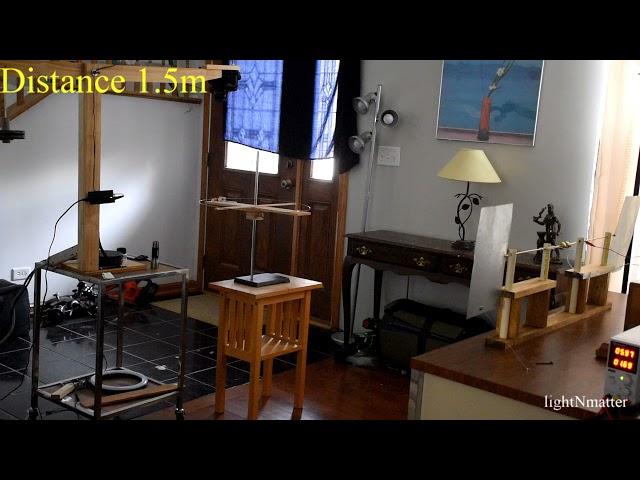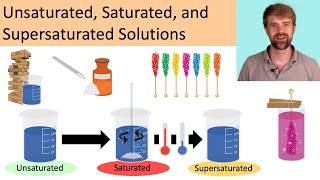
Hertz's radio wave discovery experiment
For more details visit the channel web page: www.lightnmatter.net
In this recreation of Hertz experiment, radiator (transmitter or generator ) closely resembles what Heinrich Hertz used to generate 'electric waves' in his 1892 experiment which let to the discovery of electromagnetic waves thus confirming Maxwell's electromagnetic theory. It is a basically a high frequency LC oscillator. Plates at either end provide the capacitance (Hertz used metal plates as well as metal spheres) and rods are the inductors. Induction coil injects electricity of opposite polarity to each side, which is high enough to create an electrical spark across the gap between small metal balls. Once spark is formed the ionized air lowers the resistance of the gap and makes it conductive. So charges move back and forth between metal plates at a high frequency until it dampens out in a few cycles, during which it acts as a dipole and radiates electromagnetic energy at that frequency.
The spark here is basically acting as a high frequency switch. Until vacuum triode tube was invented spark gaps were the way to generate radio waves, called spark transmitters. Their use is banned (at least in the US) now, since they generate all type of RF waves (noise) in addition to what is desired and contaminate the radio spectrum!
Hertz used a loop resonator probe/receiver similar to what is shown in this video to detect electric waves He used loops of different shapes (circulate, rectangular..) and sizes. This one is 50 cm in diameter. When EM waves go through it a spark is produced across the gap between small metal balls. Sparks are often tiny, and their length (hence the gap width) could be just few micrometers. According to Hertz sometimes he had to sit in dark for 10-15 minutes until his eyes get dark adopted to see them. The micrometer screw enables to adjust the gap precisely to see the sparks, and also to measure the gap length. . Maximum size of the gap that produced sparks had been used as an estimate of the induced electric field. Hertz's "spark gap micrometers" also had a magnifying glass attached to see the gap clearly.
This video shows detection of electric waves at various distances from the radiator.
According to Hertz accounts, he was drawn to this work when he noticed while working with Riess coils (a type of transformer used for classroom demonstration of induction) that a spark is generated in the gap of the secondary winding then the primary is energized with a small Leyden jar (type of early capacitor), But the secondary spark occurred only when there is a spark in the primary, based on this and other similar effects, after a series of experiment done in 1885/86 Hertz finally realized, and confirmed it is due to high frequency oscillation occurring in the primary circuit when there is a spark, and the sparks that were formed in a faraway circuit were due to the “ electric waves” thus generated.
Oscillatory nature of electrical spark discharges were not new, it was first suggested by Felix Savary (in Paris) in 1927 based on observations and further developed by Joseph Henry (at Princeton) in 1840s (amazingly even before proper galvanometers were available to do measurements, let alone oscilloscopes which were only available in the 20th century to visualize them). Later in 1853 William Thomson developed the theory of LC oscillations. Many before Hertz had seen the occurrence of electrical sparks in remote circuits when there is a spark in another circuit. But no one bothered to investigate what mechanism was causing it, until Hertz did.
For more details visit the channel web page www.lightnmatter.net
In this recreation of Hertz experiment, radiator (transmitter or generator ) closely resembles what Heinrich Hertz used to generate 'electric waves' in his 1892 experiment which let to the discovery of electromagnetic waves thus confirming Maxwell's electromagnetic theory. It is a basically a high frequency LC oscillator. Plates at either end provide the capacitance (Hertz used metal plates as well as metal spheres) and rods are the inductors. Induction coil injects electricity of opposite polarity to each side, which is high enough to create an electrical spark across the gap between small metal balls. Once spark is formed the ionized air lowers the resistance of the gap and makes it conductive. So charges move back and forth between metal plates at a high frequency until it dampens out in a few cycles, during which it acts as a dipole and radiates electromagnetic energy at that frequency.
The spark here is basically acting as a high frequency switch. Until vacuum triode tube was invented spark gaps were the way to generate radio waves, called spark transmitters. Their use is banned (at least in the US) now, since they generate all type of RF waves (noise) in addition to what is desired and contaminate the radio spectrum!
Hertz used a loop resonator probe/receiver similar to what is shown in this video to detect electric waves He used loops of different shapes (circulate, rectangular..) and sizes. This one is 50 cm in diameter. When EM waves go through it a spark is produced across the gap between small metal balls. Sparks are often tiny, and their length (hence the gap width) could be just few micrometers. According to Hertz sometimes he had to sit in dark for 10-15 minutes until his eyes get dark adopted to see them. The micrometer screw enables to adjust the gap precisely to see the sparks, and also to measure the gap length. . Maximum size of the gap that produced sparks had been used as an estimate of the induced electric field. Hertz's "spark gap micrometers" also had a magnifying glass attached to see the gap clearly.
This video shows detection of electric waves at various distances from the radiator.
According to Hertz accounts, he was drawn to this work when he noticed while working with Riess coils (a type of transformer used for classroom demonstration of induction) that a spark is generated in the gap of the secondary winding then the primary is energized with a small Leyden jar (type of early capacitor), But the secondary spark occurred only when there is a spark in the primary, based on this and other similar effects, after a series of experiment done in 1885/86 Hertz finally realized, and confirmed it is due to high frequency oscillation occurring in the primary circuit when there is a spark, and the sparks that were formed in a faraway circuit were due to the “ electric waves” thus generated.
Oscillatory nature of electrical spark discharges were not new, it was first suggested by Felix Savary (in Paris) in 1927 based on observations and further developed by Joseph Henry (at Princeton) in 1840s (amazingly even before proper galvanometers were available to do measurements, let alone oscilloscopes which were only available in the 20th century to visualize them). Later in 1853 William Thomson developed the theory of LC oscillations. Many before Hertz had seen the occurrence of electrical sparks in remote circuits when there is a spark in another circuit. But no one bothered to investigate what mechanism was causing it, until Hertz did.
For more details visit the channel web page www.lightnmatter.net
Комментарии:
Hertz's radio wave discovery experiment
LightNmatter
[날씨] 광주·전남 이번 주 눈·비 오락가락…곳곳 강풍 주의 / KBS 2024.11.25.
KBS NEWS 광주전남
การใช้งาน AIKA 902 เบื้องต้น @doodeestore
weedooshop weedooshop
Persefone "Inner Fullness" Guitar Cover (Rocksmith CDLC)
JokerTheAnarchist
Smart Road Trip Hacks To Solve All Your Troubles
5-Minute Crafts TEENS

![[날씨] 광주·전남 이번 주 눈·비 오락가락…곳곳 강풍 주의 / KBS 2024.11.25. [날씨] 광주·전남 이번 주 눈·비 오락가락…곳곳 강풍 주의 / KBS 2024.11.25.](https://ruvideo.cc/img/upload/RXRQTUcyamE2YW0.jpg)









![КОРОЧЕ ГОВОРЯ BALDI В РЕАЛЬНОЙ ЖИЗНИ 2 [От первого лица] | КОРОЧЕ ГОВОРЯ, ПОИГРАЛ В БАЛДИ КОРОЧЕ ГОВОРЯ BALDI В РЕАЛЬНОЙ ЖИЗНИ 2 [От первого лица] | КОРОЧЕ ГОВОРЯ, ПОИГРАЛ В БАЛДИ](https://ruvideo.cc/img/upload/UXFBMVJwZHZZLVU.jpg)














